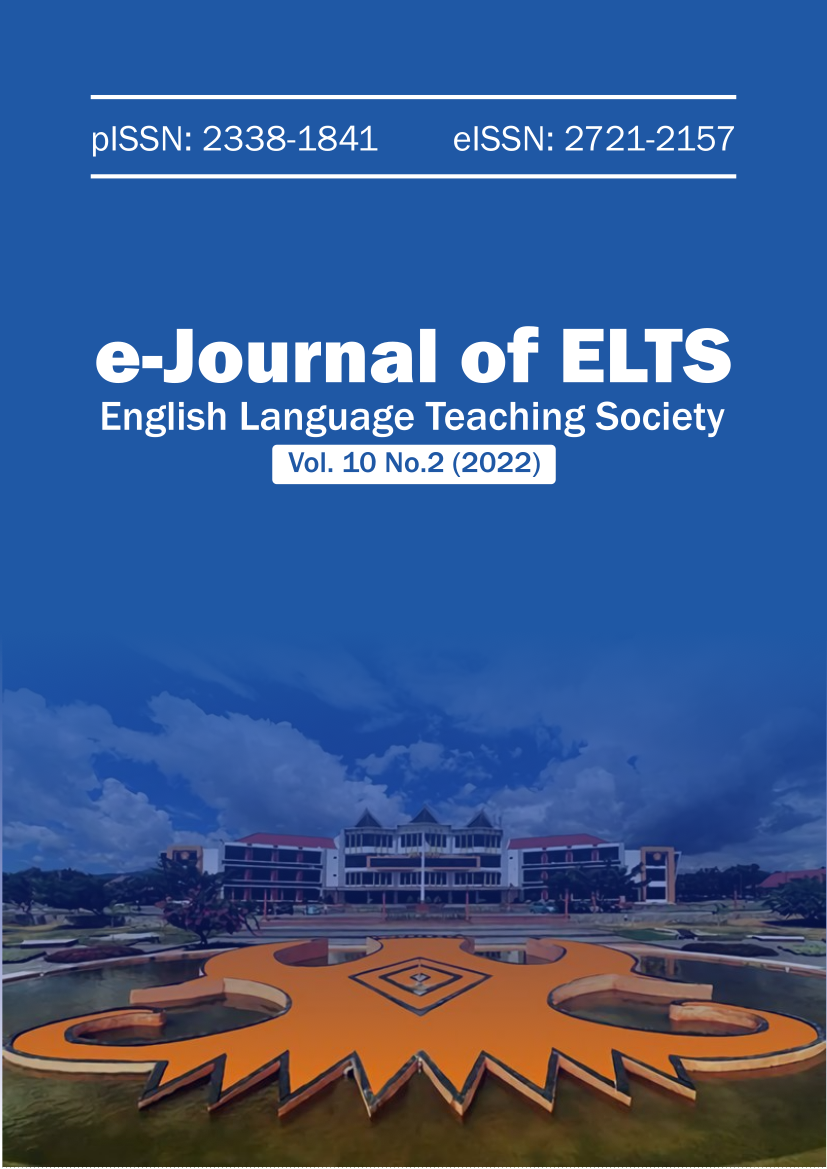PERCEPTION ON THE USE OF ZOOM IN SPEAKING CLASS OF THE THIRD YEAR STUDENTS AT TADULAKO UNIVERSITY
DOI:
https://doi.org/10.22487/elts.v10i2.2493Keywords:
Perception, Zoom, SpeakingAbstract
This study aims to know students' perceptions on the use of zoom in speaking class as an alternative solution. Whether the use of zoom as a media of online learning in speaking class is perceived positive or negative during pandemic eras of covid-19. The subjects of this research were 47 students of class 2019, the academic year 2021–2022, at Tadulako University of English Education Study Program. The research was mix method research with embedded design. The instruments used to collect data are questionnaires and interviews. The results of data analysis show that the use of zoom in speaking class perceived negatively by the student, there are many aspects influenced such as: the use of zoom application in speaking class could not fulfill the evaluation aspects of speaking skills itself, instability of internet connection interfere in the midst of knowledge transfer, financial problem in purchasing internet package, and students lack of initiative in upgrading their speaking achievement. However, there are also some positive perception that is found in this study regarding the use of zoom as a media of learning. The students agreed that the use of zoom application is helpful and could help the student learn autonomously which change their learning habit and support students to be actively engaged during speaking class. This implies that the use of the zoom application is not appropriate to be use in speaking classes. In addition, students agree that the zoom application cannot help them improve their speaking skills.
References
, A. and Joyce, H. 1997. Focus on Speaking. Sydney: Macquire University
Press
Check J., (2012.) Schutt R. K. Survey research. In: J. Check, R. K. Schutt., editors. Research methods in education. Thousand Oaks, CA:Sage Publications; pp. 159–185
Cresswell, J. W., and Plano Clark, V. L. (2011). Designing and conducting mixed methods research
Davis, F. D. (1989). Perceived usefulness, perceived ease of use, and user acceptance of information technology. MIS Quarterly, 13(3), 319-340.
Dhull, P. I., and Sakshi, M. (2017). Online Learning. International Education and
Research Journal [IERJ], 2454-9916.
Dörnyei, Z. (2007). Research methods in applied linguistics. New York: Oxford University Press
Dörnyei, Z., and Taguchi, T. (2009). Questionnaires in second language research: Construction, administration, and processing. Routledge.
Fiske, John. 1990. Cultural and Communication Studies: Sebuah Pengantar
Paling Komprehensif. Yogyakarta: Jalasutra.
Fung, P., Dey, A., Siddique, F. B., Lin, R., Yang, Y., Bertero, D., and Wu, C. S. (2016, December). Zara: a virtual interactive dialogue system incorporating emotion, sentiment and personality recognition. In Proceedings of COLING 2016, the 26th International Conference on Computational Linguistics: System Demonstrations (pp. 278-281).
Manurung, K. (2015). Improving the Speaking Skill Using Reading Contextual Internet-based Instructional Materials in an EFL Class in Indonesia. Procedia. Social and Behavioral Sciences, 176 (20): 571-579
Manurung, K. (2017). Implementing interest based instructional materials to minimize EFL learners' speaking skills de-motivating factors. Theory and Practice in Language Studies, 7(5), 356.
Menggo, S. (2021). Perception and Barrier on Using Zoom in Speaking Class During COVID-19 Pandemic
Nunan, D. (2003). Practical English Language Teaching. New York: Mc
Grow Hill Contemporary.
Pavlikova, K. (2019). Use of Monologues, Games and Problem-Solving Activities for Development of Speaking Skills. EDITORIAL TEAM, 83.
Pasaribu, T. A., Dewi, N., & Bram, B. (2021). A jesuit perspective on metaphors for covid-19 in the online journal" thinking faith". Respectus Philologicus, (39 (44)), 32-45.
Suadi, S. (2021). Students’ Perception OF THE Use OF Zoom AND Whatsapp IN ELT amidst Covid19 Pandemic. SALEE: Study of Applied Linguistics and English Education, 2(1), 51-64.
Sugiyono. (2010). Metode Penelitian Pendidikan Pendekatan Kuantitatif, kualitatif, dan R&D. Bandung: Alfabeta
Syakur. (1987). Language Testing and Evaluation. Surakarta: Sebelas Maret
University Press
Ur, Penny. (1996). A Course in Language Teaching: Practice and Theory. New
York: Cambridge University Press.
Walgito, B. (2004). Pengantar Psikologi Umum. Andi.
Yasin. M, I Students’ (2021) Perception toward the Use of Zoom for Teaching Speaking. Languge:Edu. Journal of Teaching and Learning. 10 (6) 1-25
Downloads
Published
How to Cite
Issue
Section
License
Copyright (c) 2022 Muhammad Triansyah, Konder Manurung, Wahyudin Wahyudin

This work is licensed under a Creative Commons Attribution-ShareAlike 4.0 International License.
Authors who publish with e-Journal English Language Teaching Society (ELTS) agree to the following terms:
- Authors retain copyright and grant the journal right of first publication with the work simultaneously licensed under a Creative Commons Attribution License (CC BY-SA 4.0) that allows others to share the work with an acknowledgment of the work's authorship and initial publication in this journal.
- Authors are able to enter into separate, additional contractual arrangements for the non-exclusive distribution of the journal's published version of the work (e.g., post it to an institutional repository or publish it in a book), with an acknowledgment of its initial publication in this journal.
- Authors are permitted and encouraged to post their work online (e.g., in institutional repositories or on their website) prior to and during the submission process, as it can lead to productive exchanges, as well as earlier and greater citation of published work.


